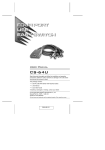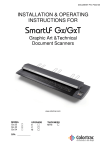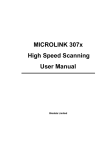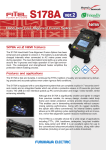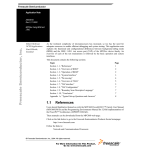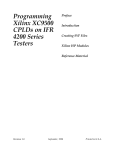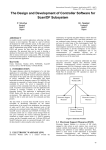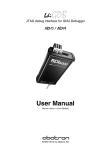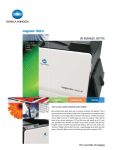Download Debug Port Design Guidelines
Transcript
Application Note #1 DEBUG PORT DESIGN GUIDELINES This document provides information on designing debug ports for different processor types, either by providing links to the processor vendor’s recommendations, or by detailed descriptions if recommendations are not available from the vendors. Note: The lists of mandatory signal/pin connections are those required by our Processor-Controlled Test (PCT) Test and Debug Solutions – other uses of the debug ports may need additional connections. INTRODUCTION Traditionally, low-level microprocessor code was debugged using an emulator. An emulator is an instrument that replaces a socketed processor, and provides the developer with the debug functions to download code, set breakpoints, single step code, and so on. As processor speed increased, it became impossible to design emulators of this type, so CPU vendors began to embed the debug functions on the processor die. Typically, these functions are accessible via the JTAG port, but in some cases proprietary interface pins are used (e.g. Freescale™ BDM). CPU vendors use different naming conventions for their debug interfaces, but throughout this document, the term debug port is frequently used as a generic term. A debug port is typically an on-board connector or series of test points that link to a set of test/debug pins on the processor package. If JTAG is used, it consists of the 5 JTAG signals and 0-3 other signals. The number of additional sideband signals required depends on the processor type. INTEL® PROCESSORS (PROCESSOR-CONTROLLED TEST 304X) Processors relevant to this section: Intel® Pentium® 4 processor FC-PGA (423 pin) Intel® Pentium® 4 processor µFC-PGA (478 pin) Mobile Intel® Pentium® 4 Processor-M (478 pin) Intel® Pentium® M processor - Centrino™ (478 pin) Intel® Celeron® processors based on the above cores Intel® Xeon® processor INT-µPGA (603 pin) Intel® Xeon® processor FC-µPGA2 (604 pin) Intel® Xeon® processor FC-µPGA2 (604 pin) Intel® Atom™ Nxxx/Exxx FC-BGA (676 pin) Intel® Atom™ Zxxx T-PBGA (518 pin) Intel® 2nd Generation Core® processor i3/i5/i7 LGA1156 (1156 pin) Intel® 2nd Generation Core® processor i7/55xx/56xx LGA1366 (1366 pin) Intel® 2nd Generation Xeon® processor E3/E5 Socket R (2011 pin) Design guidelines for debug ports: Processor-Controlled Test 304x Design-for-Test – See DFT304x document at the following address: ©2012 ASSET InterTech, Inc. 1 Application Note #1 http://www.asset-intertech.com/Products/Processor-Controlled-Test/PCT-Software.aspx#PCTResources If your board has a 60-pin male debug header (XDP), then you can use this by inserting the POD-II adapter supplied by us. Illustration 5. 60-pin male debug port header (XDP) If your board does not have a header, but has a socketed processor, you can use one of our interposer products. An interposer is a break-out PCB that sits between the processor and the socket. The POD-II is required to condition signals – this is plugged into the interposer, as shown in Illustration 6. Illustration 6. Processor Socket and Interposer Illustration 7. POD-II and Interposer If your processor is soldered, and your board does not have a debug header, then you will have to construct a simple test jig to get access to the appropriate test points (Illustration 2). Contact us if you require assistance with this. Although, the debug port specification defines a 26-pin connector (or 60 pin in the case of XDP), the pins required for the operation of PCT Test and Debug solutions are: ©2012 ASSET InterTech, Inc. 2 Application Note #1 XDP Pin 13 3 5 7 9 11 13 15 17 19 211 231 25 27 29 31 33 35 373 392 41 43 45 47 493 51 53 55 57 593 Signal Name GND OBS_FN_A0 (PREQ#) OBS_FN_A1 (PRDY#) GND OBS_DATA_A[0] OBS_DATA_A[1] GND OBS_DATA_A[2] OBS_DATA_A[3] GND OBS_FN_B0 OBS_FN_B1 GND OBS_DATA_B[0] OBS_DATA_B[1] GND OBS_DATA_B[2] OBS_DATA_B[3] GND HOOK0 (PWRGOOD) HOOK1 VCC_OBS_AB HOOK2 HOOK3 GND SDA SCL TCK1 TCK0 GND XDP Pin 2 41 61 8 10 12 14 16 18 20 221 241 26 28 30 32 34 36 38 40 42 44 46 48 50 52 54 56 58 60 Signal Name GND OBS_FN_C0 OBS_FN_C1 GND OBS_DATA_C[0] OBS_DATA_C[1] GND OBS_DATA_C[2] OBS_DATA_C[3] GND OBS_FN_D0 OBS_FN_D1 GND OBS_DATA_D[0] OBS_DATA_D[1] GND OBS_DATA_D[2] OBS_DATA_D[3] GND HOOK4 (BCLK0) HOOK5 (BCLK1) VCC_OBS_CD HOOK6 (RESET#) HOOK7 (DBR) GND TDO TRSTn TDI TMS XDP Present FreeScale™ PowerArchitecture™/IBM® PowerPC™ - COP (Processor-Controlled Test 4031) Processors relevant to this section: Freescale™ PowerArchitecture™ 740/745/750/755 Freescale™ PowerArchitecture™ 603e (200-300 MHz) Freescale™ PowerArchitecture™ 7400/7410/7450/7447A/7448/7455/7457, etc. Freescale™ PowerQUICC™ II 82xx Freescale™ PowerQUICC™ II Pro 83xx Freescale™ PowerQUICC™ III 85xx Freescale™ PowerQUICC™ III 8640/40D/41/41D IBM® PowerPC™ 750 DD2/DD3 IBM® PowerPC™ 750 CX DD1/DD2 IBM® PowerPC™ 750 FX DD1/DD2 This list may be incomplete – see our website for the latest status: The PowerPC™ Common On-Chip Processor (COP) debug port uses the processor’s JTAG bus and some additional signals. Design guidelines for COP debug ports: ©2012 ASSET InterTech, Inc. 3 Application Note #1 Processor-Controlled Test 4000 Design-for-Test. See DFT4000 document at the following address: http://www.asset-intertech.com/Products/Processor-Controlled-Test/PCT-Software.aspx See the reference manual for your specific processor, e.g. “MPC5200 Hardware Specifications”. Search for “MPC5200” on the Freescale™ website if the link below doesn’t return the document: http://www.freescale.com/files/32bit/doc/data_sheet/MPC5200.pdf?fsrch=1 If your board has a debug header, which is designed following the above specification, then you can plug directly into this. If your processor is soldered, and your board does not have a debug header, then you will have to construct a simple test jig to get access to the appropriate test points (Illustration 2). Contact us if you require assistance with this. Although the PowerPC™ COP debug port specification defines a 16-pin connector, the pins required for the operation of PCT Test and Debug solutions are: Debug Port Pin No. Signal 1 3 4 6 TDO TDI TRST VDD TCK TMS GND HRST 9 12 13 FREESCALE™ POWERARCHITECTURE™ PROCESSORS – BDM (PROCESSORCONTROLLED TEST 4033, 4034) Processors relevant to this section: Freescale™ PowerArchitecture™ 5xx Family Freescale™ PowerArchitecture™ 8xx Family The PowerArchitecture™Background Debug Mode (BDM) debug port uses a proprietary 3-pin bus with additional signals. Design guidelines for PowerArchitecture™BDM debug ports: Processor-Controlled Test 4000 Design-for-Test. See DFT4000 document at the following address: http://www.asset-intertech.com/Products/Processor-Controlled-Test/PCT-Software.aspx See the reference manual for your specific processor, e.g. Application Note AN2387/D, titled “MPC8xx Using BDM and JTAG”. Search for “AN2387” on the Freescale™ website if the link below doesn’t return the document: http://www.freescale.com/files/netcomm/doc/app_note/AN2387.pdf ©2012 ASSET InterTech, Inc. 4 Application Note #1 If your board has a 10-pin BDM debug header, which is designed following the above specification, then you can plug directly into this. If your processor is soldered, and your board does not have a debug header, then you will have to construct a simple test jig to get access to the appropriate test points (Illustration 2). Contact us if you require assistance with this. Although the PowerArchitecture™BDM debug port specification defines a 10-pin connector, the pins required for the operation of PCT Test and Debug solutions are: Debug Port Pin No. Signal 1 3 4 6 7 8 9 10 VFLS0 GND DSCLK VFLS1 HRESET DSDI VDD DSDO ARM® 7/9 PROCESSORS AND CORES (PROCESSOR-CONTROLLED TEST 4071) Processors relevant to this section: ARM® 7 processors ARM® 9 processors Any processor based on ARM®7/9 cores, such as the following: Cirrus Logic® EP9xxx Embedded Processors Conexant® ARM®7/9 networking SoC's Freescale™ MAC7100 family (Automotive) OKI Semiconductor ARM®-based MCU's The ARM® debug port uses the processor’s JTAG bus, and some additional signals. Design guidelines for ARM® debug ports: Processor-Controlled Test 4000 Design-for-Test. See DFT4000 document at the following address: http://www.asset-intertech.com/Products/Processor-Controlled-Test/PCT-Software.aspx ARM® Multi-ICE guidelines. The following User Manual contains a section that describes the debug port: http://hwbb.googlecode.com/svn/trunk/CPU/ARM/DATASHEET/ARM9/DUI0048F_MICE2_2.pdf If your board has a 20-pin debug header that is designed following the above specification, then you can plug directly into this. ©2012 ASSET InterTech, Inc. 5 Application Note #1 If your processor is soldered, and your board does not have a debug header, then you will have to construct a simple test jig to get access to the appropriate test points (Illustration 2). Contact us if you require assistance with this. Although, the ARM® debug port specification defines a 20-pin connector, the pins required for the operation of PCT Test and Debug solutions are: Debug Port Pin No. Signal 1 3 4 5 7 9 13 15 VTref nTRST GND TDI TMS TCK TDO nSRST IBM® POWERPC™ 4XX CORES Processors relevant to this section: IBM® PowerPC™ 405xx family of embedded cores IBM® PowerPC™ 440xx family of embedded cores The IBM® 4xx 16-pin debug port uses the processor’s JTAG bus, and some additional signals. Design guidelines for these debug ports: Processor-Controlled Test 4000 Design-for-Test. See DFT4000 document at the following address: http://www.asset-intertech.com/Products/Processor-Controlled-Test/PCT-Software.aspx Obtain manual from IBM®, e.g. “PowerPC 405 Processor Core User Guide” (publication no. SA142764-00). Search for “ppc405fx_um” on the IBM® website if the link below doesn’t return the document: http://www-01.ibm.com/chips/techlib/techlib.nsf/techdocs/D060DB54BD4DC4F2872569D2004A30D6 If your board has a 16-pin debug header, which is designed following the above specification, then you can plug directly into this. If your processor is soldered, and your board does not have a debug header, then you will have to construct a simple test jig to get access to the appropriate test points (Illustration 2). Contact us if you require assistance with this. Although, the IBM® debug port specification defines a 16-pin connector, the pins required for the operation of PCT Test and Debug solutions are: ©2012 ASSET InterTech, Inc. 6 Application Note #1 Debug Port Pin No. Signal 1 3 4 6 7 9 16 TDO TDI TRST Power Sense TCK TMS GND ASSET CONTACTS: Please contact your ScanWorks sales representative for more information. ASSET InterTech, Inc. 2201 N. Central Expy., Ste 105 Richardson, TX 75080 +1 888 694-6250 or +1 972 437-2800 http://www.asset-intertech.com ©2012 ASSET InterTech, Inc. 7







